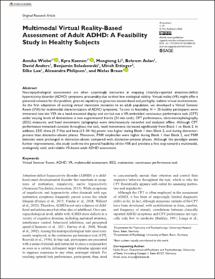Multimodal Virtual Reality-Based Assessment of Adult ADHDA Feasibility Study in Healthy Subjects

Multimodal Virtual Reality-Based Assessment of Adult ADHD
A Feasibility Study in Healthy Subjects

| dc.contributor.author | Wiebe, Annika | |
| dc.contributor.author | Kannen, Kyra | |
| dc.contributor.author | Li, Mengtong | |
| dc.contributor.author | Aslan, Behrem | |
| dc.contributor.author | Anders, David | |
| dc.contributor.author | Selaskowski, Benjamin | |
| dc.contributor.author | Ettinger, Ulrich | |
| dc.contributor.author | Lux, Silke | |
| dc.contributor.author | Philipsen, Alexandra | |
| dc.contributor.author | Braun, Niclas | |
| dc.date.accessioned | 2023-03-30T09:20:57Z | |
| dc.date.available | 2023-03-30T09:20:57Z | |
| dc.date.issued | 18.04.2022 | |
| dc.identifier.uri | https://hdl.handle.net/20.500.11811/10742 | |
| dc.description.abstract | Neuropsychological assessments are often surprisingly inaccurate in mapping clinically-reported attention-deficit hyperactivity disorder (ADHD) symptoms, presumably due to their low ecological validity. Virtual reality (VR) might offer a potential solution for this problem, given its capability to generate standardized and yet highly realistic virtual environments. As the first adaptation of existing virtual classroom scenarios to an adult population, we developed a Virtual Seminar Room (VSR) for multimodal characterization of ADHD symptoms. To test its feasibility, N= 35 healthy participants were immersed into the VSR via a head-mounted display and carried out a VR-embedded continuous performance task (CPT) under varying levels of distractions in two experimental blocks (24 min each). CPT performance, electroencephalography (EEG) measures, and head movements (actigraphy) were simultaneously recorded and analyzed offline. Although CPT performance remained constant throughout the task, head movements increased significantly from Block 1 to Block 2. In addition, EEG theta (4–7 Hz) and beta (13–30 Hz) power was higher during Block 1 than Block 2, and during distractor-present than distractor-absent phases. Moreover, P300 amplitudes were higher during Block 1 than Block 2, and P300 latencies were prolonged in distractor-absent compared with distractor-present phases. Although the paradigm awaits further improvements, this study confirms the general feasibility of the VSR and provides a first step toward a multimodal, ecologically valid, and reliable VR-based adult ADHD assessment. | en |
| dc.format.extent | 19 | |
| dc.language.iso | eng | |
| dc.rights | Namensnennung-Nicht kommerziell 4.0 International | |
| dc.rights.uri | http://creativecommons.org/licenses/by-nc/4.0/ | |
| dc.subject | Virtual Seminar Room | |
| dc.subject | ADHD | |
| dc.subject | VR | |
| dc.subject | multimodal assessment | |
| dc.subject | EEG | |
| dc.subject | inattention | |
| dc.subject | continuous performance task | |
| dc.subject.ddc | 600 Technik | |
| dc.subject.ddc | 610 Medizin, Gesundheit | |
| dc.title | Multimodal Virtual Reality-Based Assessment of Adult ADHD | |
| dc.title.alternative | A Feasibility Study in Healthy Subjects | |
| dc.type | Wissenschaftlicher Artikel | |
| dc.publisher.name | Sage | |
| dc.rights.accessRights | openAccess | |
| dcterms.bibliographicCitation.pagestart | 1 | |
| dcterms.bibliographicCitation.pageend | 19 | |
| dc.relation.doi | https://doi.org/10.1177/10731911221089193 | |
| dcterms.bibliographicCitation.journaltitle | Assessment | |
| ulbbn.pubtype | Zweitveröffentlichung | |
| dc.version | publishedVersion | |
| ulbbn.sponsorship.oaUnifund | OA-Förderung Universität Bonn |
Files in this item
This item appears in the following Collection(s)
-
Publikationen (10)




